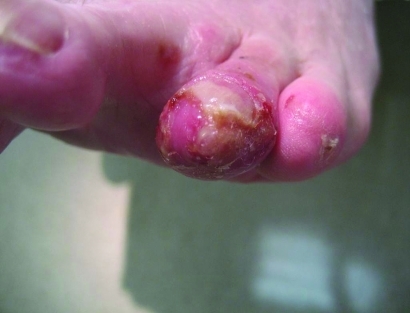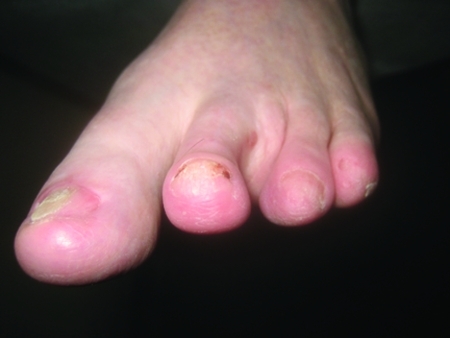Abstract
Acrodermatitis continua of Hallopeau, first described by Hallopeau in 1890, is an uncommon variant of pustular psoriasis. Acrodermatitis continua of Hallopeau presents as sterile pustules on the hands and feet. It has a relapsing course. Although acrodermatitis continua of Hallopeau is a pustular psoriasis variant, the condition is not easily treated with antipsoriatic medications. In the following case, the authors report a case of acrodermatitis continua of Hallopeau successfully treated with adalimumab. In addition, the cases of acrodermatitis continua of Hallopeau treated with tumor necrosis-alpha inhibitors are summarized.
A 79-year-old man with a history of gout and chronic obstructive pulmonary disease (COPD) presented to the dermatology clinic two years after having his third phalanx of the left foot amputated for “chronic infection.” He was concerned that a similar process was recurring on the left fourth phalanx.
On physical examination, erythema, crusting, focal erosion, and pustules were present on the distal portion of the left fourth phalanx (Figure 1). The nail was dystrophic and the nail bed was also studded with pustules. The clinical examination was consistent with acrodermatitis continua of Hallopeau (ACH).
Figure 1.
Left phalanx, previous to treatment
The patient had failed prior treatment with numerous oral antibiotics and topical corticosteroids. After further history, he recalled having been seen by an outside dermatologist and was treated with two infliximab infusions. The infliximab was discontinued due to a severe episode of shortness of breath during the second infusion.
The authors initially treated the patient with tazarotene gel and tacrolimus ointment without improvement. He was then treated with topical clobetasol, which also failed to improve his condition. A methotrexate course was discontinued due to a possible history of pulmonary fibrosis, and a course of mycophenolate mofetil was discontinued due to intolerable gastrointestinal pain. He underwent a series of 20 excimer 308nm laser treatments without benefit. After obtaining baseline labs and a negative purified protein derivative (PPD) test, the patient was treated with adalimumab 80mg at Week 1, 40mg at Week 2, and 40mg every two weeks thereafter. One month after initiating adalimumab, his toe showed dramatic improvement (Figure 2). He continued to improve clinically; however, the adalimumab was placed on hold due to an episode of diverticulitis following colonoscopy.
Figure 2.
Left phalanx after one month of treatment with adalimumab
Discussion
Acrodermatitis continua of Hallopeau presents as a relapsing, sterile pustular eruption of the hands and feet.1 ACH was first described as a suppurative process that affects the fingertips and hands in 1890 by Hallopeau.2 The disease process may result in sclerosis and osteolysis if left untreated.1 In addition, onychodystrophy and anonychia can result from pustulation of the nail bed and nail matrix.3
ACH is regarded as an uncommon variant of pustular psoriasis that does not readily respond to traditional antipsoriatic medications. Numerous topical and systemic treatments have been utilized in the treatment of ACH including phototherapy, topical and systemic vitamin A derivatives, topical vitamin D derivatives, and immunosuppressants. Since ACH is related to plaque psoriasis, it is postulated that tumor necrosis factor (TNF)- α inhibitors may have a role in the treatment of ACH.
Adalimumab, which proved successful in the treatment of the patient in this case, is a recombinant human immunoglobulin G1 (IgG1) monoclonal antibody that targets human TNF-α. The monoclonal antibody blocks the interaction between TNF-α and its cell surface receptors, specifically p55 and p75. In vitro, adalimumab in combination with complement acts to lyse cells expressing TNF on their surface.4 In addition, adalimumab effects downstream processes that are regulated by TNF, such as the enhancement of adhesion molecule levels, which direct leukocyte migration.4
The majority of the cases of ACH successfully treated with TNF-α inhibitors in the literature are summarized in Table 1. Including the patient described in this case, there have been six cases of ACH that have responded well to treatment with adalimumab.5–7 Two of the cases reported were treated with adalimumab in combination with cyclosporine.6 The success of adalimumab in these patients allowed cyclosporine to be discontinued.6 One case combined adalimumab with prednisone to reach adequate improvement in the patient.5 A case of successful ACH treatment with efalizumab has been reported in the literature.8 However, this agent was withdrawn from the market in 2009 due to a proposed increased risk of progressive multifocal leukoencephalopathy. The literature also describes two cases of patients responding to treatment with infliximab.9–10 Five case reports exist to support etanercept as a treatment for ACH.11–15
TABLE 1.
Cases of acrodermatitis continua of Hallopeau successfully treated with TNF-α inhibitors
| DEMOGRAPHICS | FAILED TREATMENTS | SUCCESSFUL TREATMENTS |
|---|---|---|
| 79-year-old male (the authors' patient) | Excimer laser; mycophenolate mofetil; infliximab; methotrexate; tazarotene; topical corticosteroids; topical tacrolimus; systemic antibiotics | Adalimumab |
| 20-year-old female5 | Oral prednisolone; methotrexate monotherapy; methotrexate and sulfasalazine | Adalimumab and prednisone |
| 72-year-old female6 | psoralen plus ultraviolet; retinoid-psoralen plus ultraviolet A (UVA) treatment; topical agents; infliximab combined with methotrexate; efalizumab; etanercept in combination with cyclosporin | Adalimumab with a brief overlap of cyclosporin |
| 61-year-old female6 | Topical agents; narrow band-UVB; etanercept in combination with methotrexate | Adalimumab combined with cyclosporine for a period of treatment |
| Female6 | Methotrexate | Adalimumab |
| 72-year-old female7 | Topical corticosteroids; calcipotriene; cyclosporine; methotrexate; acitretin; mycophenolate mofetil; PUVA; etanercept monotherapy; etanercept with methotrexate | Adalimumab |
| 62-year-old female8 | Topical steroids; calcipotriol; topical antibiotics; systemic antibiotics; acitretin | Efalizumab |
| 60-year-old female9 | Topical corticosteroids; cyclosporine; methotrexate; etanercept; efalizumab; acitretin; oral prednisone; azathioprine | Infliximab |
| 58-year-old male10 | Topical glucocorticoids; systemic glucocorticoids; calcipotriol; acitretin; antibiotics; cyclosporine | Infliximab |
| 64-year old11 | Acitretin; etretinate; PUVA; colchicine; thalidomide; methotrexate; cyclosporine; efalizumab; infliximab | Etanercept |
| 50-year-old female12 | Topical corticosteroids; calcitriol; calcipotriol; tacrolimus; bath-PUVA; acitretin | Etanercept |
| 76-year-old male13 | Topical corticosteroids; methotrexate; calcipotriene; acitretin; mtx, calcipotriene, PUVA | Etanercept in combination with desoximetasone ointment |
| 65-year-old14 | — | Etanercept in combination with acitretin and topical corticosteroids |
| 74-year-old male15 | Dapsone complicated by neuropathy | Etanercept |
Conclusion
ACH is postulated to be a variant of pustular psoriasis. It follows a chronic clinical course and is often resistant to many traditional modalities used to treat psoriasis. TNF-α inhibitors have shown efficacy in numerous treatment refractory cases of ACH, supporting the relationship of TNF to this family of disorders. The use of TNF inhibitors is an excellent addition to our ACH armamentarium.
Footnotes
DISCLOSURE:The authors report no relevant conflicts of interest.
REFERENCES
- 1.Bordignon M, Zattra E, Albertin C, Belloni-Fortina A. Successful treatment of a 9-year-old boy affected by acrodermatitis continua of Hallopeau with targeted ultraviolet B narrow-band phototherapy. Photodermatol Photoimmunol Photomed. 2010;26(1):41–43. doi: 10.1111/j.1600-0781.2009.00468.x. [DOI] [PubMed] [Google Scholar]
- 2.Hallopeau MH. Sur une asphyxie locale des extremities avec polydactylite suppurative chronique et pousse’s ephemeres de dermatite pustuleuse disseminee et symetrique. Soc Fr Dermatol Syph Bull. 1890;1:39–45. [Google Scholar]
- 3.Waller J, Wu J, Murase J, Dyson S, Kelly K. Chronically painful right thumb with pustules and onycholysis. Qiagnosis: Acrodermatitis continua of Hallopeau. Clin Exp Dermatol. 2007;32(5):619–620. doi: 10.1111/j.1365-2230.2007.02440.x. [DOI] [PubMed] [Google Scholar]
- 4.DailyMed Current Medication Information. [October 24, 2010]. http://dailymed.nlm.nih.gov/dail ymed/about.cfm
- 5.Müeller R, Ogilvie A, Schwarz S, Kern P, Schett G, et al. Adalimumab treatment of a patient with psoriasis suppurativa Hallopeau associated osteoarthropathy. Clin Exp Dermatol. 2009;27(5):887. [PubMed] [Google Scholar]
- 6.Ryan C, Collins P, Kirby B, Rogers S. Treatment of acrodermatitis continua of Hallopeau with adalimumab. Br J Dermatol. 2009;160(1):203–205. doi: 10.1111/j.1365-2133.2008.08893.x. [DOI] [PubMed] [Google Scholar]
- 7.Puig L, Barco D, Vilarrasa E, Alomar A. Treatment of acrodermatitis continua of Hallopeau with TNF-blocking agents: case report and review. Dermatology. 2010;220(2):154–158. doi: 10.1159/000277415. [DOI] [PubMed] [Google Scholar]
- 8.Balato N, Gallo L, Balato A, La Bella S, Ayala F. Acrodermatitis continua of Hallopeau responding to efalizumab therapy. J Eur Acad Dermatol Venereol. 2009;23(11):1329–1330. doi: 10.1111/j.1468-3083.2009.03156.x. [DOI] [PubMed] [Google Scholar]
- 9.Rubio C, Martin M, Arranz S, et al. Excellent and prolonged response to infliximab in a case of recalcitrant acrodermatitis continua of Hallopeau. J Eur Acad Dermatol Venereol. 2009;23(6):707–708. doi: 10.1111/j.1468-3083.2008.02998.x. [DOI] [PubMed] [Google Scholar]
- 10.Mang R, Ruzicka T, Stege H. Successful treatment of acrodermatitis continua of Hallopeau by the tumour necrosis factor-alpha inhibitor infliximab (Remicade) Br J Dermatol. 2004;150(2):379–380. doi: 10.1111/j.1365-2133.2003.05761.x. [DOI] [PubMed] [Google Scholar]
- 11.Thielen A, Barde C, Marazza G, Saurat JH. Long-term control with etanercept (Enbrel) of a severe acrodermatitis continua of Hallopeau refractory to infliximab (Remicade) Dermatology. 2008;217(2):137–139. doi: 10.1159/000134613. [DOI] [PubMed] [Google Scholar]
- 12.Weisshaar E, Diepgen TL. Successful etanercept therapy in therapy refractory acrodermatitis continua suppurativa Hallopeau. J Ger Soc Dermatol. 2007;5(6):489–492. doi: 10.1111/j.1610-0387.2007.06332.x. [DOI] [PubMed] [Google Scholar]
- 13.Bonish B, Rashid R, Swan J. Etanercept responsive acro-dermatitis continua of Hallopeau: is a pattern developing? J Drugs Dermatol. 2006;5(9):903–904. [PubMed] [Google Scholar]
- 14.Kazinski K, Joyce K, Hodson D. The successful use of etanercept in combination therapy for treatment of acrodermatitis continua of Hallopeau. J Drugs Dermatol. 2005;4(3):360–364. [PubMed] [Google Scholar]
- 15.Nikkels A, et al. Etanercept and recalcitrant acrodermatitis continua of Hallopeau. J Drugs Dermatol. 2006;5(8):705–706. [PubMed] [Google Scholar]




